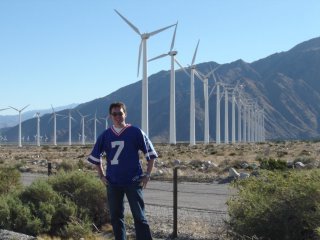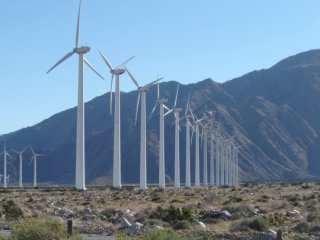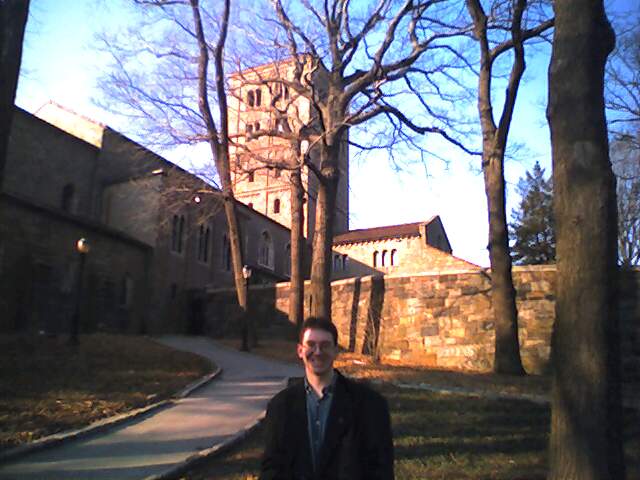Wind Power!
 Driving East along I-10 in Southeastern California, you run into the very large "wind farm" in San Gorgonio (near Palm Springs, east of Los Angeles). This is one of the state's three largest sources of wind power, which provides 1.5 percent of the state's electricity. According to the state power commission:
Driving East along I-10 in Southeastern California, you run into the very large "wind farm" in San Gorgonio (near Palm Springs, east of Los Angeles). This is one of the state's three largest sources of wind power, which provides 1.5 percent of the state's electricity. According to the state power commission:In the year 2004, wind energy in California produced 4,258 million kilowatt-hours of electricity, about 1.5 percent of the state's total electricity. That's more than enough to light a city the size of San Francisco.
 But how do these things produce energy? According to this website, it's pretty simple:
But how do these things produce energy? According to this website, it's pretty simple:Wind plants use large blades to catch the wind, turning rotors that produce electricity. Just as fossil-fueled plants use steam or combustion gases to turn electricity-producing rotors, wind plants use many wind turbines, often assembled on a large single wind site called a wind farm, to generate electricity. The modern wind farm may consist of as many as 100-500 wind turbines connected to the electric transmission grid.
Wind turbines commonly begin to produce power at a wind speed of 10-12 miles per hour. Wind plants produce electricity only when the wind blows, so if the wind is not blowing, the plant is not producing electricity. For this reason, wind is called an intermittent resource.
 But then again, what causes wind? Thank God for the Internet, because I can easily look this stuff up at sites that talk about the history of wind:
But then again, what causes wind? Thank God for the Internet, because I can easily look this stuff up at sites that talk about the history of wind:Wind is air in motion. It is produced by the uneven heating of the earth’s surface by the sun. Since the earth’s surface is made of various land and water formations, it absorbs the sun’s radiation unevenly. When the sun is shining during the day, the air over landmasses heats more quickly than the air over water. The warm air over the land expands and rises, and the heavier, cooler air over water moves in to take its place, creating local winds. At night, the winds are reversed because the air cools more rapidly over land than over water. Similarly, the large atmospheric winds that circle the earth are created because the surface air near the equator is warmed more by the sun than the air over the North and South Poles. Wind is called a renewable energy source because wind will continually be produced as long as the sun shines on the earth. Today, wind energy is mainly used to generate electricity.
 So wind is the perfect source of energy, right? It's becoming more popular around the world. It solves all of our energy problems, and we don't have to go to war with Arabs to produce what we need. It sounds great.
So wind is the perfect source of energy, right? It's becoming more popular around the world. It solves all of our energy problems, and we don't have to go to war with Arabs to produce what we need. It sounds great.Well, it does have some problems, one being wind isn't very reliable. The other is, ironically enough, environmentalists don't always like them, according to Wired, as they have a nasty habit of killing migrating birds if placed in the wrong location:
A 2004 report by the California Energy Commission found that 880 to 1,300 raptors are killed at Altamont every year, such as red-tailed hawks and the federally protected golden eagle.
Altamont isn't the only scene of a showdown. Environmental groups have already blocked a proposed wind-power facility in the Mojave Desert, and opponents of another project, in Nantucket Sound, have cited wildlife concerns in their lobbying efforts. A recent government report found that sites in other regions could pose a threat to bats.
Bats! Oh my.
 But they look cool, and that's what important. They are so cool, in fact, that there are organized tours for them. For a, uh, nominal fee, you can join other people who have websites and look at propellers and wind. This has got to be a great place to pick up chicks.
But they look cool, and that's what important. They are so cool, in fact, that there are organized tours for them. For a, uh, nominal fee, you can join other people who have websites and look at propellers and wind. This has got to be a great place to pick up chicks.And that's what's really important.
Because then, we can save energy and turn off the lights.
RELATED LINKS:
America's Treasures
Archive of Religion, Science and Philosophy



2 Comments:
If you're gonna pick up chicks and then turn out the light, you're gonna need all the energy you can get.... That's not a good way to conserve energy, my dear.
I got some wind power for you
Post a Comment
|<< Home